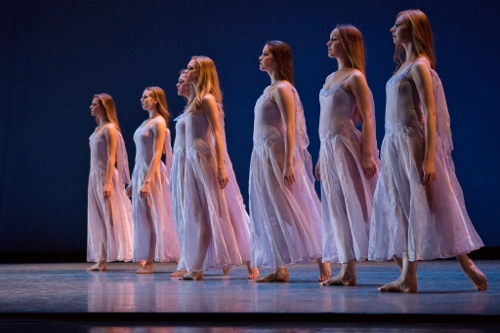|
 |
|
|
 |
 |
Indiana University Ballet Theater boldly and tenderly presented Balanchine’s four attributes — foremost as a choreographer and ballet master who honored each dancer under his care — stretching each into the best possible company member; as a teacher providing principles and standards of expression as the springboard for strength, fluidly, speed, intelligence in every presentation; as a poet, whose aesthetic embraced lyricism, character development, humor, sensitivity in every work; and as a showman who made ballet essential 80 years ago when ballet was not on anyone’s go-to radar. Balanchine showed us what we need to be as a people with heart and soul, civility and joyfulness. “Ballet is important and significant…yes, But first of all, it is a pleasure.” IU Ballet Theater used this Balanchine quote in its promotion of their Spring program, March 25-26, 2016 at IU's Musical Arts Center. Pleasure indeed with four works showcasing the mettle of a company willing to master Masterworks. "Serenade," Balanchine’s first ballet set upon his first group of students at the School of American Ballet he initiated with co-founder Lincoln Kirstein in 1934, was created to close that first year of holding classes with a group of young dancers who didn’t always show up for class, and if they did, arrived on their own timeline. Balanchine lifted these circumstances into a higher level. Interpreting Tchaikovsky’s music as a salute to ensemble, he embraced an American ethic of teamwork into a realm of measuring the worth of self in relation to one’s ability and willingness to work together. He stamped an American style onto a European art form with a bent toward elitism and star power. The metaphor is upfront—we always are in a state of transition—through loss we gain; through sorrow we seek strength to endure. His first year students did not have the skills to present the classic Giselle, but they could -and did- have the ability to interpret its theme of inspiration, dedication and spark of divinity awaiting each of us. From the opening moment of becoming at-one-ness as a corps, arms upraised, palms outward in anticipation of rising above mundaneness, to the final instant when the many merge as one —indivisible, vulnerable —it is a gaze toward renewal in the eyeblink of loss. Drama sweeps us into the realm of the ancient gods. On March 24, the New York Public Library for the Performing Arts hosted a program centered on the transformation of "Serenade" over the past eight decades. One hopes it will have been recorded for us in the hinterland to learn what dance critics Alastair Macaulay (New York Times) and Robert Greskovic (Wall Street Journal) had to say about Balanchine’s ability to grow his choreography as a living, breathing entity. "Raymonda Variations," set to the romantic score by Glazunov, “demands virtuosity from every dancer” reads the promo for the IU Ballet Spring Program, and a procession of dancers delivered beautifully as soloists embracing the music as an extension of "my personality as told by myself," yet within the context of corps. Individuals operate within the context of the group. The corps work indeed was dazzling. "Elégie" interprets Stravinsky’s embrace of love and loss in the tradition of the poetics of ancient Greece. A corps of female dancers, barefoot with hair loose is a total change from hair bound in a bun and feet bound in point shoes, setting the scene for the demanding pas de deux, reflecting the music’s flow and variety through the bodies of two dancers weaving in and out of their connectivity while rooted to one spot. Emotion-packed, it is like one long sigh with a final release of breath. Elegance was at the essence for Elizabeth Yanick and Glenn Kelich, featured at the March 26 program that I attended. (Cara Hansvick and Colin Ellis danced the roles March 25.) In contrast, Danielle Cesanek and Tyler Dowdy endowed "Tarantella," set to Gottschalk's sprightly music, with a large dollop of “anything you can do I can do better,” until they concede that being in love gives unity a notch above individuality, and yet there’s one more bit of up-[wo]man-ship… One wonders, will these two individualists live happily ever after? Stuart Chafetz conducted the fine orchestra, with excellent solo playing moments. Patrick Mero was lighting designer. Artistic director Michael Vernon is chair of the IU Ballet Department. Re-staging works as representatives of the George Balanchine Trust were Repetiteurs Victoria Simon, Deborah Wingert and Darla Hoover. Carter Alexander and Melinda Roy were guest coaches. Gouping Wang was Ballet Master and Shawn Stevens was Ballet Mistress. If you missed IU Ballet Theater’s season closer, you can catch a Balanchine tribute program May 21 and 22 at The Toby at the Indianapolis Museum of Art as part of the Indianapolis School of Ballet tenth anniversary program. Victoria Simon is restaging excerpts from "The Four Temperaments," the waltz from "Raymonda Variations" and "Serenade." Sandra Jennings will restage "Emeralds" from Jewels, Nilas Martins will restage "Concerto Barocco." Victoria Lyras, ISB founding artistic director and an adjunct faculty member of the IU Ballet Department, is restaging "Tarantella." All are Repetituers of the George Balanchine Trust.
 (L-R) Colin Ellis, Cara Hansvick and Raffaella Stroik in George Balanchine's "Serenade." Photo © & courtesy of IU Opera And Ballet Theater |
|
 (L-R) Cara Hansvick, Colin Ellis, Imani Sailers and Raffaella Stroik in George Balanchine's "Serenade." Photo © & courtesy of IU Opera And Ballet Theater |
|
 (F-B) Raffaella Stroik, Colin Ellis and Cara Hansvick in George Balancchine's "Serenade." Photo © & courtesy of IU Opera And Ballet Theater |
|
 Danielle Cesanek and Tyler Dowdy in George Balanchine's "Tarantella." Photo © & courtesy of IU Opera And Ballet Theater |
|
 (L-R) Ryan McCreary, Megan Klamert, Elizabeth Yanick, Cara Hansvick, Alexandra Hartnett, Sarah Young and Lauren Lane in George Balanchine's "Elégie." Photo © & courtesy of IU Opera And Ballet Theater |
|
|
|






